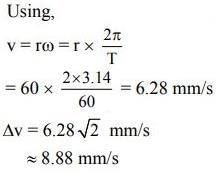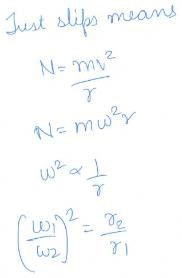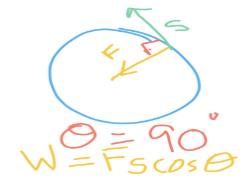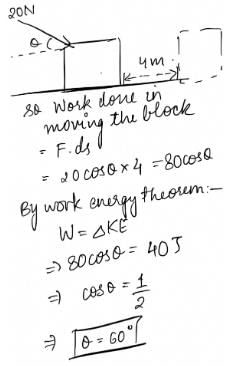Test: Work, Energy & Power - 2 - NEET MCQ
30 Questions MCQ Test Topic-wise MCQ Tests for NEET - Test: Work, Energy & Power - 2
A wheel is at rest. Its angular velocity increases uniformly and becomes 80 radian per second after 5 second. The total angular displacement is :
A wheel is subjected to uniform angular a cceleration about its axis. Initially its angular velocity is zero. In the first 2 sec, it rotates through an angle q1 ; in the next 2 sec, it rotates through an additional angle q2. The ratio of q2 / q1 is-
The linear and angular acceleration of a particle are 10 m/sec2 and 5 rad/sec2respectively it will be at a distance from the axis of rotation -
A wheel having a diameter of 3 m starts from rest and accelerates uniformly to an angular velocity of 210 r.p.m. in 5 seconds. Angular acceleration of the wheel is -
The second’s hand of a watch has length 6 cm. Speed of end point and magnitude of difference of velocities at two perpendicular positions will be
The ratio of angular speed of hours hand and seconds hand of a clock is-
The angular velocity of earth about its axis of rotation is-
A stone of mass 0.5 kg tied with a string of length 1 metre is moving in a circular path with a speed of 4 m/sec. The tension acting on the string in Newton is-
Two bodies A & B rotate about an axis, such that angle qA (in radians) covered by first body is proportional to square of time, & qB (in radians) covered by second body varies linearly. At t = 0, qA = qB = 0. If A completes its first revolution in sec. & B needs 4p sec. to complete half revolution then; angular velocity wA : wB at t = 5 sec. are in the ratio
A car of mass 1000 kg moves on a circular track of radius 20 m. if the coefficient of friction is 0.64, what is the maximum velocity with which the car can be moved?
The earth, radius 6400 km, makes one revolution about its own axis in 24 hours. The centripetal acceleration of a point on its equator is nearly -
A stone of mass 0.1 kg tied to one end of a string 1.0 m long is revolved in a horizontal circle at the rate of 10/p revolution per second. Calculate the tension of the string ?
A coin placed on a rotating turn table just slips if it is at a distance of 40 cm from the centre if the angular velocity of the turntable is doubled, it will just slip at a distance of
A particle moves in a circle of radius 25 cm at two revolutions per second. The acceleration of particle in m/s2 is -
The graphs below show angular velocity as a function of time. In which one is the magnitude of the angular acceleration constantly decreasing?
A particle moves along a circle of radius m with constant tangential acceleration. If the velocity of the particle is 80 m/s at the end of the second revolution after motion has begun, the tangential acceleration is :
A particle moves with deaceleration along the circle of radius R so that at any moment of time its tangential and normal accelerations are equal in moduli. At the initial moment t = 0 the speed of the particle equals v0, then:
(i) the speed of the particle as a function of the distance covered s will be
(A) v = v0 e_s/R (B) v = v0es/R (C) v = v0e_R/s (D) v = v0eR/s
(ii) the total acceleration of the particle as function of velocity and distance covered
(A) a = (B) a =
(C) a =
(D) a =
If angular velocity of a disc depends an angle rotated q as w = q2 + 2q, then its angular acceleration a at q = 1 rad is
A particle is going in a uniform helical and spiral path separately as shown in figure with constant speed.
If the radii of circular paths of two particles of same masses are in the ratio of 1 : 2, then in order to have same centripetal force, their speeds should be in the ratio of :
A rigid body of mass m is moving in a circle of radius r with a constant speed v. The force on the body is and is directed towards the centre. What is the work done by this force in moving the body over half the cirumference of the circle.
A body travels through a distance of 10 m on a straight line, under the influence of 5 N . If the work done by the force is 25J, the angle between the force and displacement is-
A blocks is moved from rest through a distance of 4m along a straight line path. The mass of the blocks is 5 kg. and the force acting on it is 20 N . If the kinetic energy acquired by the block be 40J, at what angle to the path the force is acting-
The work done in pushing a block of mass 10 kg from bottom to the top of a frictionless inclined plane 5 m long and 3 m high is- (g = 9.8 m/sec2)
A force F = (3x + 4
) Newton (where x is in metres) acts on a particle which moves from a position (2m, 3m) to (3m, 0m). Then the work done is
If a man increases his speed by 2 m/sec, his K.E. is doubled. The original speed of the man is-
A block of mass m is suspended by a light thread from an elevator. The elevator is accelerating upward with uniform acceleration a. The work done by tension on the block during t seconds is :
In a typical power station, amid a series of energy transfers and conversions, about 70% of the energy input gets wasted in the form of thermal energy, the efficiency of such a power station is about
A body of mass m accelerates uniformly from rest to a speed v0 in time t0. The work done on the body till any time t is
A light spring of length 20 cm and force constant 2 kg/cm is placed vertically on a table. A small block of mass 1 kg falls on it. The length h from the surface of the table at which the ball will have the maximum velocity is -
|
9 docs|1259 tests
|






























